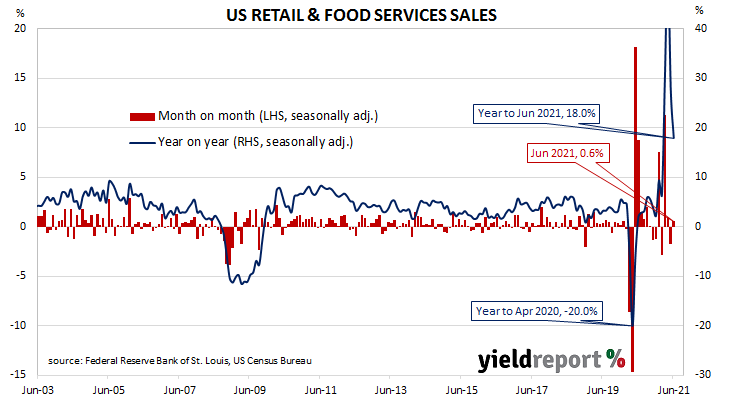Summary: US retail sales rise by 0.6% in June; rise in contrast to -0.5% expected; sales volatile so far in 2021 but “strong overall”; report alleviates concerns US consumers may turn cautious; rises in majority of retail categories; “vehicles and parts” the largest single influence, falls 2%.
US retail sales had been trending up since late 2015 but, commencing in late 2018, a series of weak or negative monthly results led to a drop-off in the annual growth rate below 2.0% by the end of that year. Growth rates then increased in trend terms through 2019 and into early 2020 until pandemic restrictions sent it into negative territory. A “v-shaped” recovery then took place which was followed by some short-term spikes as federal stimulus payments hit US households in early 2021.
According to the latest “advance” sales numbers released by the US Census Bureau, total retail sales increased by 0.6% in June. The rise was in contrast to the 0.5% decline which had been generally expected and May’s 1.7% fall after it was revised down from -1.3%. On an annual basis, the growth rate slowed from May’s revised figure of 27.6% to 18.6% as the pandemic-induced reduction in spending during the June 2020 quarter continued falling out of the calculations.
“Retail sales have been volatile this year due to the impact of government stimulus payouts but have been strong overall,” said Westpac senior economist Lochlan Halloway.

The report was released on the same day as the University of Michigan’s July consumer confidence report and US Treasury bond yields hardly moved on the day. By the end of it, the 2-year Treasury yields remained unchanged at 0.23%, the 10-year yield had slipped 1bp to 1.29% while the 30-year yield finished unchanged at 1.92%.
NAB currency strategist Rodrigo Catril said, ”[T]he overall strength of the report alleviated concern the cashed-up US consumer with $2.5 trillion of savings may turn cautious as we have seen in other economies.” However, he also pointed out “some commentators also noted how the figures were flattered by higher inflation.”
The majority of categories recorded higher sales over the month. However, the “Motor vehicle & parts dealers” segment provided the largest single influence on the overall result, falling by 2.0% for the month while still remaining 19.5% higher for the year. Sales at food and drinking places, general merchandise stores and petrol (“gasoline”) stations also had significant influences on the total, each rising by 2.3%, 1.9% and 2.5% respectively.

